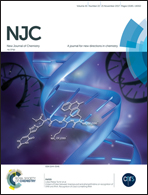Organic salt-derived nitrogen-rich, hierarchical porous carbon for ultrafast supercapacitors†
Abstract
Nitrogen-rich, hierarchical porous carbons with high surface area were simply prepared by direct pyrolysis of a nitrogen-containing organic salt, i.e. ethylenediaminetetraacetic acid calcium disodium salt (EDTANa2Ca), as electrode materials for supercapacitors. Besides micropores originating from the elimination of some small molecular substances, the template effects of nano-CaO and nano-Na2CO3 particles (the intermediate products derived from EDTANa2Ca) created some meso/macropores, resulting in a developed hierarchical porous structure. As the pyrolysis temperature increases from 600 °C to 850 °C, the nitrogen content decreases from 10.8 at% to 1.48 at%, whereas both the BET surface area and the pore volume increase dramatically. The BET surface area and pore volume of the carbon prepared at 850 °C reach as high as 2015 m2 g−1 and 1.74 cm3 g−1, respectively, and the meso/macropores account for about 70% of the total pore volume. The developed hierarchical porous structure enables the carbon to exhibit excellent rate capability. It can endure an ultrafast scan rate of 5000 mV s−1 and an ultrahigh charge/discharge current up to 200 A g−1 with a capacitance of 115 F g−1 in 6 mol L−1 KOH.



 Please wait while we load your content...
Please wait while we load your content...